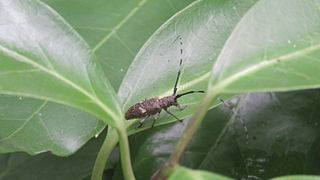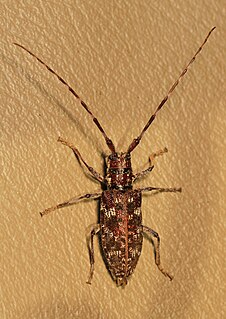
Matthew Raymond Dillon is an American actor and film director. He made his feature film debut in Over the Edge (1979) and established himself as a teen idol by starring in the films My Bodyguard (1980), Little Darlings (1980), the three S. E. Hinton book adaptations Tex (1982), Rumble Fish (1983), The Outsiders (1983) and The Flamingo Kid (1984). From the late 1980s onward, Dillon achieved further success, starring in Drugstore Cowboy (1989), Singles (1992), The Saint of Fort Washington (1993), To Die For (1995), Beautiful Girls (1996), In & Out (1997), There's Something About Mary (1998), and Wild Things (1998). In a 1991 article, famed movie critic Roger Ebert referred to him as the best actor within his age group, along with Sean Penn.

Monochamus is a genus of longhorn beetles found throughout the world. They are commonly known as sawyer beetles or sawyers, as their larvae bore into dead or dying trees, especially conifers such as pines. They are the type genus of the Monochamini, a tribe in the huge long-horned beetle subfamily Lamiinae, but typically included in the Lamiini today.

Monochamus scutellatus, commonly known as the white-spotted sawyer or spruce sawyer or spruce bug, is a common wood-boring beetle found throughout North America. It is a species native to North America.

Lamiini is a tribe of longhorn beetles of the subfamily Lamiinae.
Monochamus accri is a species of beetle in the family Cerambycidae. It was described by Dillon and Dillon in 1959, originally under the genus Laertochamus.
Monochamus benito is a species of beetle in the family Cerambycidae. It was described by Dillon and Dillon in 1959.
Monochamus fallax is a species of beetle in the family Cerambycidae. It was described by Dillon and Dillon in 1959.
Monochamus ogowensis is a species of beetle in the family Cerambycidae. It was described by Dillon and Dillon in 1959, originally under the genus Nigrolamia.
Monochamus reticulatus is a species of beetle in the family Cerambycidae. It was described by Dillon and Dillon in 1959.
Monochamus thoas is a species of beetle in the family Cerambycidae. It was described by Dillon and Dillon in 1961.
Monochamus tropicalis is a species of beetle in the family Cerambycidae. It was described by Elizabeth S. Dillon and Lawrence S. Dillon in 1961, originally under the genus Ethiopiochamus.

Monochamus subfasciatus is a species of beetle in the family Cerambycidae. It was described by Henry Walter Bates in 1873. It is recorded from Japan where it infests Japanese red pine and is a vector of the nematode Bursaphelenchus doui.
Monochamus adamitus is a species of beetle in the family Cerambycidae. It was described by James Thomson in 1857. It is known from Tanzania, Sierra Leone, Angola, Ghana, Mozambique, the Ivory Coast, Senegal, the Democratic Republic of the Congo, Malawi, and Zimbabwe.
Monochamus griseoplagiatus is a species of beetle in the family Cerambycidae. It was described by James Thomson in 1858. It is known from Sierra Leone and Gabon.

Monochamus sutor is a species of beetle in the family Cerambycidae. It was described by Carl Linnaeus in 1758, originally under the genus Cerambyx. It has a wide, natural distribution throughout Europe, and has also been introduced into Belgium and the Netherlands. Adults measure between 15 to 24 mm, and larvae measure up to 45 mm (1.8 in).

The spotted pine sawyer is a species of beetle in the family Cerambycidae. It was described by John Lawrence LeConte in 1852.

Monochamus galloprovincialis, the pine sawyer beetle, also referred to as the black pine sawyer beetle, is a species of beetle in the family Cerambycidae. It was described by Olivier in 1795, originally under the genus Cerambyx. It has a wide distribution, occurring naturally throughout Europe and the Caucasus. It has also been introduced into the Canary Islands. It serves as a vector for the parasitic nematode species Bursaphelenchus xylophilus, and also acts as a host to the parasitoid wasp species Dolichomitus tuberculatus.
Monochamus leuconotus is a species of beetle in the family Cerambycidae. It was described by Francis Polkinghorne Pascoe in 1869, originally under the genus Anthores. It is known from Tanzania, Cameroon, Malawi, Kenya, Mozambique, Namibia, South Africa, Uganda, the Democratic Republic of the Congo, Zambia, Angola, and Zimbabwe. It feeds on Coffea arabica.
Monochamus ruspator is a species of beetle in the family Cerambycidae. It was described by Johan Christian Fabricius in 1781, originally under the genus Lamia. It has a wide distribution throughout Africa.

Monochamus sartor is a species of beetle in the family Cerambycidae. It was described by Johan Christian Fabricius in 1787, originally under the genus Lamia. It is known from throughout Europe, as well as in Kazakhstan, Mongolia, North Korea and South Korea. It is rated by the IUCN as Least Concern.








